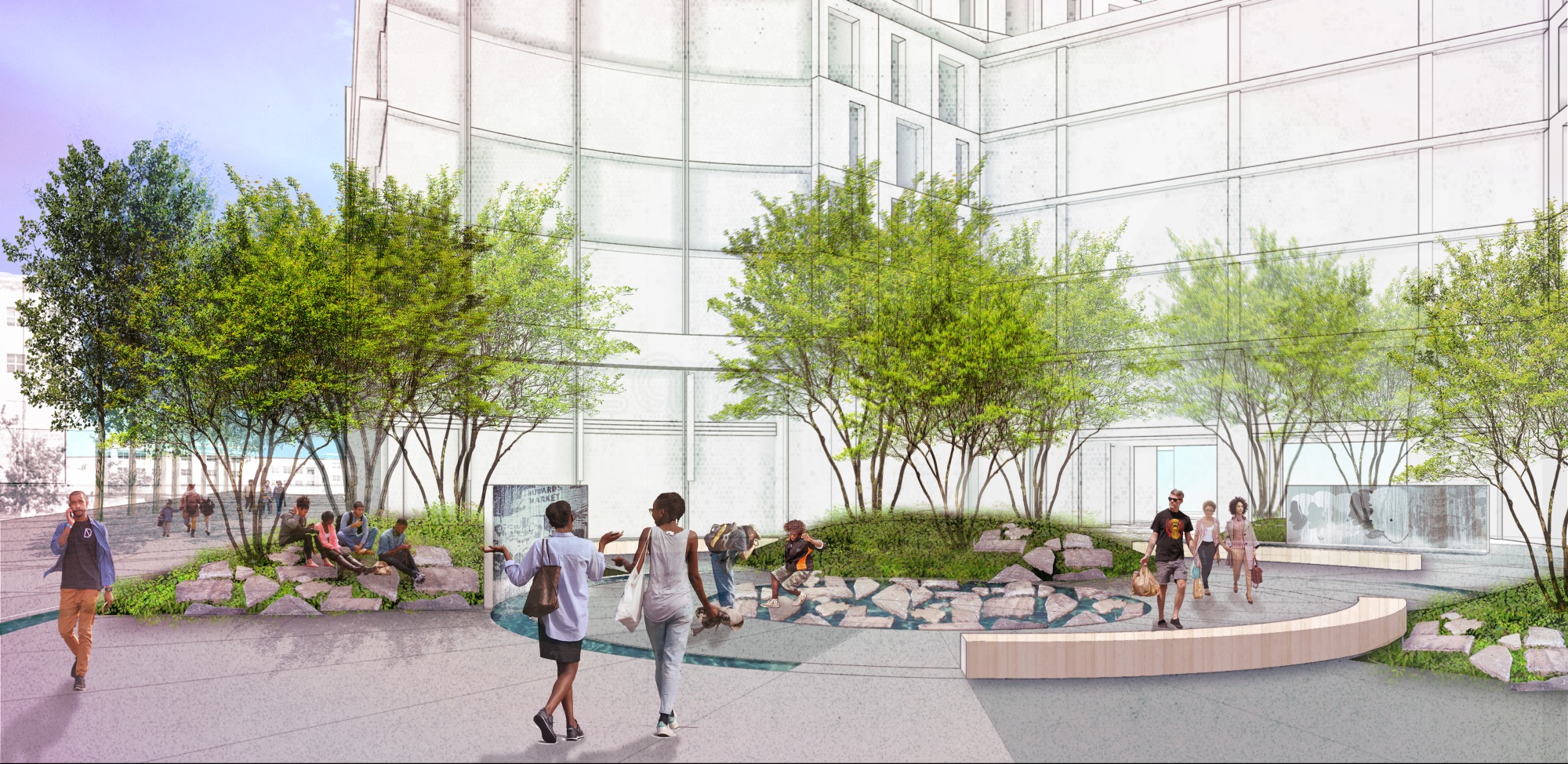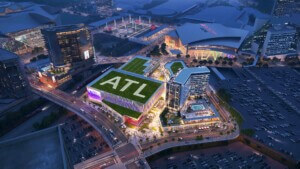In many, if not most, major American cities where available real estate is at a premium, a soon-to-be-redundant 471,000-square-foot building in the heart of downtown would typically be ripe for a standard raze-and-redevelop scheme—commercial office space, condos, maybe a mixed-use hotel and retail project—particularly if the original use of the building renders adaptive reuse less viable. Atlanta, at the moment, has such a building.
After 25 years of serving as a detention center, the 11-story precast concrete-clad brick structure at 254 Peachtree Avenue SW will soon start a second chapter. The fortress-like mid-rise might be left standing and transformed into something else or it could be demolished to make way for something new; that has yet to be decided. But thanks to a 2019 initiative spearheaded by Atlanta Mayor Keisha Lance Bottoms and pushed forward by social justice advocates, that something will be atypical, radical even: A community-driven reimagining of a building purpose-built for incarceration into a multifaceted “services hub” where those who have been impacted by over-incarceration will be able to forge new paths and make new connections via educational, economic, recreational, and cultural opportunities.
“By converting this space, the City of Atlanta seeks to invest in people to break the cycle of poverty while at the same time improving public safety practices and opportunities that reduce recidivism and rebuild lives,” the project’s website reads.
Whatever form it might take, the Atlanta City Detention Center (ACDC) will become a Center for Equity.
Completed in 1995 for $56 million, the ACDC is a hulking 1,300-person capacity arrest processing and detention facility for inmates charged with low-level crimes. During Mayor Bottoms’ tenure, the ACDC has been semi-deserted due in large part to sweeping reforms passed by the mayor including an end to municipal cash bail, the termination of a long-term contract with ICE to hold detainees, and less harsh penalties on minor infractions like the possession of small amounts of marijuana. The reforms have been so successful that they’ve, as mentioned, all but emptied out the jail, which is also experiencing increased operating costs. On a typical day, the ACDC’s population hovers around 150 detainees—roughly 9 percent capacity—according to the city.
In a victory for organizers who have long campaigned for the closure of the ACDC, Bottoms, who first called for the jail to be closed in 2018, signed historic legislation last summer that authorized the underutilized jail to be shuttered and ordered the formation of the Reimagining ACDC Task Force.

Invited to help imagine what alternative uses for a decommissioned place of incarceration might look like and asked to provide recommendations to the mayor, the diverse faction of 52 Atlantans was composed of city officials and stakeholders along with a core group of 25 committee members including justice reform activists, faith leaders, lawyers, and at least one celebrity rapper. Marilynn B. Winn, co-founder and executive director of Women on the Rise GA, Rashad Taylor, a senior advisor to Mayor Bottoms, and Bill McGahan, chairman of Georgia Works!, served as task force co-chairs.
“The final closure of this Detention Center symbolizes a new era for the city of Atlanta,” said Bottoms in a statement. “Transforming this space into a Center for Equity replaces City-subsidized incarceration with something more effective—equipping residents with the tools they need to succeed. Taking this critical step will both result in meaningful change for Atlanta and set a new standard for the rest of the nation.”
This June, just a year after Bottoms ordered the jail to be closed, four design concepts for a Center for Equity that could replace the ACDC—two involve repurposing the building, and two involve demolishing it—were submitted to the city along with a 26-page report generated by the task force recommending that the jail be “closed, demolished, and replaced with the Center for Equity to support the many Atlantans that need its services.”

A key player during the community engagement process that involved over 600 Atlanta residents was Designing Justice + Designing Spaces (DJDS), a nonprofit architecture and real estate development firm based in Oakland, California, dedicated to putting an end to mass incarceration and fostering equitable, just communities. As the firm wrote in a blog post detailing its involvement as part of the Reimagining ACDC Task Force Planning Team:
“Given the scale of the endeavor and the call from the Mayor to engage the entire city, this project seemed daunting at first. However, we instantly and humbly knew that we did not have all of the answers, but we do have expertise in devising strategies to design with the people who do have answers—in this case, those who have been directly impacted by the jail. After being invited by the community organizers to join the effort, and then joining the planning team to support and be held accountable by the Mayor’s Task Force, we dove into a process of designing the community engagement strategy and then the trauma informed tools needed not only to collect information and ideas, but also to gain the trust of the community.”
Community engagement tools used by the DJDS team included custom-developed board games, building blocks, and other activities and apparatus that promoted dialogue, brought community concerns to the forefront, and also provided lessons to participants on the basics of real estate development, design, and more.

As Shelley Davis Roberts, an architectural associate with DJDS who served on the team, elaborated to AN, two previously developed games, the Stop/Start/Continue game and the Menu Cards game, were used along with two newly created games: The Seat at the Table Game and the Space Planning and Finance Game.
The Seat at the Table Game, as described in a December 2019 Task Force progress report shared by Roberts, “invites participants to an uncommon seat at the table during the design process, letting them know that their voices and ideas are valued. Participants use the Menu Cards to develop a list of ‘ingredients’ consisting of stakeholders and programs/uses. They then ‘break bread’ and share ideas while gathering and arranging blocks that represent the programs and uses they would like to see on each floor of the building resulting in a colorful three-dimensional representation of their ideas within the context of south downtown Atlanta.”

As for the Space Planning and Finance game, it was created to “get the community thinking creatively about the potential uses for the Center for Equity and gain a critical understanding of the relationship to cost.” During the first round of the activity, participants gain a better understanding of space planning, scale, and programming and use of space. Round two is centered around learning the basics of financing a building.
Describing the inaugural city-wide meeting—full Reimagining ACDC Task Force included—that kicked off the process as a “huge success,” the DJDS team, as part of a larger 24-person planning team, quickly got to work with community members by placing them in the roles of experts from the get-go, a method that as, the firm put it, “is designed to demonstrate and prove that we value their input and lived experiences. This approach helped cut through the tension, and it made way for difficult conversations and deep listening to take place.”

Twelve months and multiple community town halls, listening sessions, and workgroup meetings later, the quartet of design schemes formulated by DJDS are each unique in vision yet all place the specific needs and wants of the community first in the transformation of a “major and symbolic piece of city infrastructure.”
Two of the concepts, as mentioned, call for the demolition of the ACDC entirely. One housing-centered proposal, the Center for Equity Campus, would make way for three new smaller buildings flanking a memorial plaza. Its estimated development cost was the highest at $108 million. The other new build concept, Distributed Equity, wouldn’t entail erecting a new structure at the site at all—instead, the ACDC would be demolished and replaced with a large urban green space, potentially an urban farm or a park that, as detailed by DJDS, would feature an array of community-benefiting attributes like an outdoor theater, water features, “story wall,” and a grove of Paw Paw trees. In lieu of one central facility, a network of smaller Centers for Equity, housed in new or repurposed buildings, would be established in neighborhoods across Atlanta.

As for the concepts that leave the ACDC standing, both repurposing proposals included in the task force’s report call for removing the facade’s precast concrete panels so that the exterior is rendered less forbidding and its interior less tenebrous. The darkness of the building, both figuratively and literally, is cast out. One approach, the Equity Podium, places the Center for Equity on the first two floors of the building and its basement. Non-center tenants would share the space, helping to finance programming and services.
The other reuse strategy, the “catalytic” Downtown Anchor, calls for the Center for Equity to be spread throughout the entire building. Both concepts call for the use of bold colors, public art, and a design strategy that pulls “design elements from nature to support healing and creating a synergistic experience between the building and the body” per DJDS. Central to the adaptive reuse approach is a natural light-strewn, double-height “Supper Lobby” that serves as a warm and welcoming informational hub where one can find access a multitude of services, retail, community gathering space, and more.

Data collected and analyzed by the team showed that dedicated community event and recreational spaces along with a one-stop resource services center were at the top of the community’s list of desired features to be included in the center. “While housing was important, transitional housing overwhelmingly leads the charge,” read the progress report shared by Roberts. “Many people want to improve the choices, quality, and access to good food while creating jobs. Many recognized the importance of integrating arts and culture into all aspects of the Center.”
It was anticipated that one of the four design strategies borne from DSDJ’s wholly collaborative work with the Reimagining ACDC Task Force would be selected to move forward to the next stage by the city later this year. However, as pointed out by Roberts, the timeline for deliberating and making a final choice is currently in flux due to the COVID-19 pandemic.











